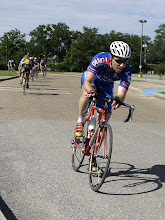I'm sure this analogy will breakdown at some point, but I thought it was worth the effort of expounding.
Within the sport of competitive cycling, there are several camps that take various principles as supreme. There's the aerodynamic camp, the power camp, the mileage camp, and so forth. But tucked away without a voice are a couple other camps that determine the extent of success or potential for failure.
Now, to my analogy...
A sports car has all the elements of a cyclist. It has to breathe, it has a source of power(engine or muscle), it has joints and it has a source of control(electric circuitry). For the point of this discussion, we will leave out the gears.
If we were charged with the task of designing the sports car, we would have to start with such basic elements that most people over look them. Somehow, we have to connect the power source to the wheels in the most effective, efficient means possible. The power from that engine would have to be delivered in a manner that the transaxle could handle it. Also, we would have to design electrical circuitry to provide control of how the power is delivered. Without these elements, power and aerodynamics are useless.
In the world of cycling, this is biomechanics and neuromuscular control. Biomechanics encompass the various aspects of bicycle fitting. It deals with joint positions, length tension ratios of muscles, weight distribution and breathing. Neuromuscular control has to do with pedaling efficiency, balance and bicycle control. Without these elements, power and aerodynamics are ultimately useless. Without laying the foundations of biomechanics and neuromuscular control, there will be a greater likelihood of discomfort, injury and ineffectiveness.
What about power and aerodynamics? Which one comes first within the priority scheme?
Here's how I would answer that. Get on your bike and get in an aerodynamic position but
don't apply any power to the pedals. Now sit up straight. What is the difference in your bike speed?
You have to be able to apply power first before aerodynamics becomes a concern. The same thing applies to our sports car. If we design an aerodynamic sports car without an engine, how fast will it go? I'm not saying the aerodynamics are not important...I'm just saying that they are lower on the priority scheme.
Power: Power is developed by your training program(miles, intensity, durations etc.). Everyone wants to go here first. Everyone wants to ride fast. I like to ride fast. But, before I ride fast, I have to lay the foundations. This discourse is getting too long to include principles of training.
Aerodynamics: Finally, we are here. Let's return to the sports car analogy. If we apply an aerodynamic chassis that causes the engine to change alignment with the transaxle, what's going to happen to performance? It will either diminish or destroy performance. If we apply a chassis that limits air intake to the engine, what happens to performance?
So, when we return to the aerodynamic setup on the bike, what happens if I assume the aero postion and alter my ability to effectively pedal? Or, what if my position alters my ability to breathe? We will get diminished performance.
Here's your priority scheme. Biomechanics reigns supreme followed by neuromuscular control. Then power followed by aerodynamics.
Get fit to your bike, learn how to pedal, train hard, assume aerodynamic positions that respect higher priorities and win.

